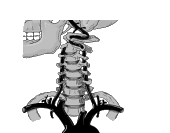Note that some links will break as pages are moved, websites are abandoned, etc.
If this happens, please try searching for the page in the Wayback Machine at www.archive.org.

Adverse events associated with spinal manipulation. Regarding neck manipulation, the risk/benefit ratio for the procedure appears to be in question due to the availability of safer options.
NOTE: In the UK, there appears to be no publicised national system for reporting adverse events related to chiropractic treatment. Furthermore, the UK General Chiropractic Council's current promotional literature appears to make no mention of serious risks.
Related links
"So far, we know for sure that mild to moderate as well as serious complications, including deaths, do occur after chiropractic spinal manipulations, particularly those of the upper spine. What we cannot say with absolute certainty is whether they are caused by the treatment or whether they happened coincidentally. Our knowledge in this area relies mostly on case-reports and surveys which, by their very nature, do not allow causal inferences. Therefore chiropractors have, in the past, been able to argue that a causal link remains unproven. A brand-new blinded parallel group RCT might fill this gap in our knowledge and might reject or establish the notion of causality once and for all...what does this new study tell us? In my view, it is strong evidence to suggest a causal kink between chiropractic treatment and mild to moderate adverse effects." Edzard Ernst's blog (27th June 2013)
Video (49:54 mins) produced by Canadian Victims of Chiropractic Neck Manipulation: "This video is not a high priced production. The tragedies are felt at home, so this is where the stories are told. It is the best these families can do. They don't have millions of dollars to spend as the chiropractors did in the inquest into the death of Lana Dale Lewis. Yet, with less than one percent of the resources, the truth did again prevail. Chiropractic neck manipulation does cause death."
"Australian researchers have just...[published] a systematic review aimed at systematically reviewing all reports of serious adverse events following lumbo-pelvic SMT...The authors' conclusion was that this systematic review describes case details from published articles that describe serious adverse events that have been reported to occur following SMT of the lumbo-pelvic region. The anecdotal nature of these cases does not allow for causal inferences between SMT and the events identified in this review...The authors make a strong point about the fact that case reports never allow causal inference. One can only agree with this notion. However, the precautionary principle in medicine also means that, if case reports provide reasonable suspicion that an intervention might led to adverse-effects, we need to be careful and should warn patients of this possibility. It also means that it is up to the users of SMT to demonstrate beyond reasonable doubt that SMT is safe." Edzard Ernst (23rd June 2013)
"A team of Swiss and UK chiropractors just published a survey to determine which management options their colleagues would choose in response to several clinical case scenarios...In my view, the findings of this survey are deeply worrying and the interpretation of the authors is not far from an attempt to 'white-wash' the results. Like with most investigations of this nature, the results are wide open to selection bias; particularlythe dismal UK response rate begs many questions. In all likelihood, reality is much worse than implied by the results of this investigation. And these results clearly show that, even with a fairly dramatic safety incident, chiropractors fail to respond adequately. There is no doubt in my mind: chiropractors put patients at risk." Edzard Ernst (10th June 2013)
According to the U.S. National Practitioner Data Bank, between September 1, 1990 and January 29, 2012, a total of 5,796 chiropractic medical malpractice reports were filed. Common reasons for the lawsuits were strokes and other injuries.
Brash v Accident Compensation Corporation [2013] NZACC 23 (1 February 2013)
CONCLUSIONS: Calcified carotid artery may be at risk for embolization following cervical spinal manipulation. Our recommendation is that, patients with extensively calcified carotid arteries should refrain from aggressive neck maneuvers and cervical spine manipulation therapy to avoid liberation of cerebral embolus. J Neuroimaging. (20th July 2012)
Am Surg. (September 2012)
“Although incidence of cervical artery dissection precipitated by chiropractic neck manipulation is unknown, it is an important risk. Given that risk, physical therapy exercises may be a safer option than spinal manipulation for treating patients with neck pain.” Conclusion of a letter from Raymond E. Bertino, MD, Arun V. Talkad, MD, Jeffrey R. DeSanto, MD, Jane H. Maksimovic, DO, and Shyam G. Patel, MD. Ann Intern Med. (17th July 2012)
A case report describing a patient who regularly practiced self-manipulation of her neck who presented with shoulder and neck pain and was undergoing a vertebral artery dissection. Journal of Chiropractic Medicine (December 2011)
Conclusion: Adverse effects are poorly reported in recent RCTs of chiropractic manipulations.
Edzard Ernst and Paul Posadzki, Journal of the New Zealand Medical Association, (20th April 2012)
“I’m going to spread this out thru Facebook, Twitter and everything else”. He also reveals that chiropractors are contacting him a lot because they don’t want him to say anything negative about them.
Talk given at the American Heart Association Stroke Awareness Luncheon at The Colony Hotel, Palm Beach, Florida, on 26th January 2012
Christa Orsino was 39 years old when chiropractic stroke changed her life forever. American Heart Association Stroke Awareness Luncheon (26th January 2012)
“If the history is suspicious for dissection (head and neck trauma, recent cervical
chiropractic manipulation…)” Curr Treat Options Neurol (December 2011)
“This case report describes a 50-year-old man who developed neurological symptoms a few hours after manipulation (high velocity low amplitude [HVLA] technique) of the cervical spine. Magnetic resonance (MR) imaging of the cervical spine revealed intramedullary high signal at the C2/3 level of the right side of the cervical cord on the T2-weighted images. The potential mechanism of injury and causes of the radiological appearance are discussed.” Source: Clinical Radiology, University Hospital of Wales, Cardiff. Acta Radiol. (24th October 2011)
This authoritative study finds that chiropractic manipulation of the cervical spine is a known cause of craniocervical arterial dissections: “These injuries can be severe, requiring endovascular stenting and cranial surgery. In this patient series, a significant percentage (31%, 4/13) of patients were left permanently disabled or died as a result of their arterial injuries.” Journal of Neurosurgery (16th September 2011)
His family claims that during his chiropractic appointment, Youngblood began vomiting and sweating profusely. The medical examiner said he later died from a stroke caused by manipulation of the neck. (June 2011)
“Craniocervical arterial dissection is one of the most common causes of ischaemic stroke in young people and is occasionally associated with neck manipulation. Identification of individuals at risk will guide risk management…Mild mechanical trauma to the head and neck was significantly associated with craniocervical arterial dissection (OR 23.53). Cardiovascular risk factors for stroke were less evident in the dissection group (3)”. Manual Therapy (August 2011)
“We observed and treated a 42-year-old patient who complained a rapid onset of saddle hypoparesthesia and urine retention only a few hours after the spinal manipulation performed for L5-S1 herniated disc. The comparison of the two following MRIs performed before and after the manipulations seems to prove a close pathogenetic relationship.” Tamburrelli FC, Genitiempo M, Logroscino CA. European Spine Journal (15th March 2011)





